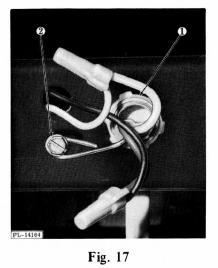|
Thread Number: 45064
Question for stevet about my KDS-58 |
[Down to Last] |
| Post# 660686 2/16/2013 at 15:10 (4,080 days old) by barcoboy (Canada) | ||

Using the service manual, I was able to get the old power cord and reel out of the machine fairly easily. However, I was surprised to see that the wires did not end up in the field wiring compartment box, but were simply attached to L1 and L2 via wire nuts that were located close to the drain solenoid. There was also a couple of loose wire ties that guided the wires across one side of the bottom of the frame to where the wire nuts were, and also a short piece of electrical tape around each wire nut. The ground wire from the power cable was attached to the proper location on the frame. Just wondering if this is how power is normally hooked up on a portable model, or was the field wiring compartment box always used? I'm thinking of wiring my new cord up so that it does terminate in the box just to be safe, but just wondering if that's how it was supposed to be and someone has already changed the power cord on my dishwasher once before incorrectly.
| ||

|
| Post# 660810 , Reply# 2 2/17/2013 at 14:02 (4,079 days old) by barcoboy (Canada) | ||

Thanks stevet.
The operation was a success. I went to the local hardware store and picked up an outdoor extension cord containing #14 wire. Brought it home and cut the female end off of it leaving the plug and the wire. Was able to feed it through the opening at the back of the dishwasher and get it around the cord reel, and then fed the rest to what the service manual refers to as the "field wiring compartment", which is a couple of holes through the front cross-member on the right hand side covered by a metal box that is held in place by a tab and one screw. I ran my extension cord wire through a cable clamp, passed L1 and L2 through a smaller hole which was tapered out (to prevent sharp edges that the wire could be cut on I'm guessing, instead of passing through a rubber grommet) and connected them to my cord with wire nuts. There was a ground screw inside the box, so I loosened that and took a piece of bare copper wire, wrapped it around the screw one turn and tightened it, then twisted it to my cord's ground wire and fastened it as well with a wire nut. The other end of the bare ground wire after the ground screw I ran out the box, then continued it along the front of the cross-member and fastened it to a location on the left hand side which was where the ground wire from the old cord was attached. There was also a sticker in this location saying it was where the ground was supposed to attach. I didn't see any terminal blocks when I looked, but I believe this is the correct way to wire it up. The service manual supports that, as on page 14, you can see figure 17 shows a dishwasher wired up using two wire nuts. (Attached the photo). I believe, at least in Canada, it is okay to use wire nuts as long as they are contained within an enclosed metal box, and that the metal box itself is grounded. The box also must be easily accessible at all times, so it can't be hidden behind a wall for example. I'm still curious as to whether or not mine was wired up correctly before I changed the cord. The way the ground was attached looked like it was done at the factory, but attaching the main power lines to L1 and L2 using wire nuts out in the open and not using the power box to shield them? Dunno. Anyways, I plugged it in, and ran a Rinse and Hold no problem. My next wash is going to be a Sani so that the water heater can run for a while. When I was first testing it, my clamp meter showed it draws about 12.5 amps... tea time! :-) 
| ||
| Post# 661372 , Reply# 3 2/20/2013 at 22:14 (4,076 days old) by barcoboy (Canada) | ||
 | ||
| Post# 661374 , Reply# 4 2/20/2013 at 22:16 (4,076 days old) by barcoboy (Canada) | ||
 | ||
| Post# 661375 , Reply# 5 2/20/2013 at 22:17 (4,076 days old) by barcoboy (Canada) | ||
 | ||
Post# 661410 , Reply# 6 2/21/2013 at 06:50 (4,075 days old) by combo52  (50 Year Repair Tech Beltsville,Md) (50 Year Repair Tech Beltsville,Md) |
||
Power Cord Connection On A KA Portable DW The metal junction box was supplied for use IF the DW was to be installed permanently and connected directly to the homes electrical system. When the DW was a portable DW, it is just that another major appliance, your local and national electrical codes do not govern how the machines power cord gets attached. How the appliance is built and wired is governed by UL and CSA? in Canada, and it is common and widely accepted to use wire nuts, crimp connections, and many different type of different terminal connections inside an appliance without having them inside any type of metal enclosure. Just look at all the wiring hanging all over the place under this DW and many other major appliances. | ||

 Comes to the Rescue!
Comes to the Rescue!